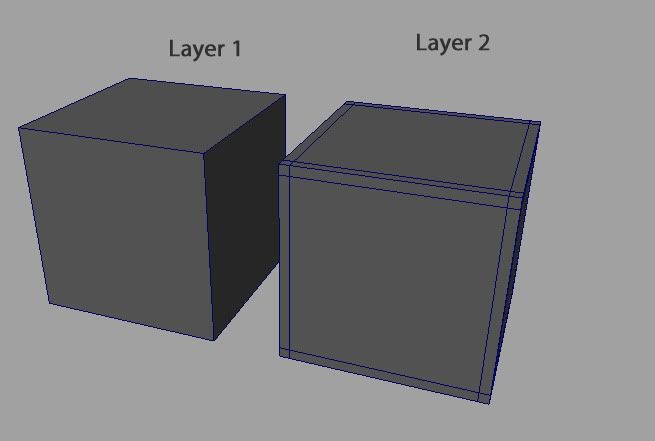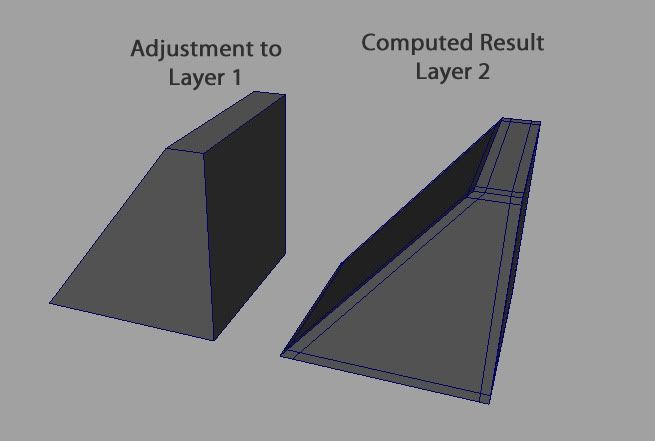The BRAWL² Tournament Challenge has been announced!
It starts May 12, and ends Oct 17. Let's see what you got!
https://polycount.com/discussion/237047/the-brawl²-tournament
It starts May 12, and ends Oct 17. Let's see what you got!
https://polycount.com/discussion/237047/the-brawl²-tournament
High Poly Modeling Tools
Don't know if there is something out there like this or not, but I could see it being an extremely useful toolset.
As it stands now, tight edge loops or beveling can be a pain to tweak if large changes need to be made, and the end results can sometimes eat up time and create headaches.
The basic principal would be a layer system that would work alongside a subdivision system.
The subdivision system would work like any of them. The layer system would work like a subdivision system in that you could move up and down in your divisions, but each level would allow you complete creation control. This would make changes a lot easier and would also open up doors for creating multiple versions off one mesh like a layer system does now which could be achieve from something like "true layers" or "sub layers"....
IS there something like this? Forgive my ignorance if there is


As it stands now, tight edge loops or beveling can be a pain to tweak if large changes need to be made, and the end results can sometimes eat up time and create headaches.
The basic principal would be a layer system that would work alongside a subdivision system.
The subdivision system would work like any of them. The layer system would work like a subdivision system in that you could move up and down in your divisions, but each level would allow you complete creation control. This would make changes a lot easier and would also open up doors for creating multiple versions off one mesh like a layer system does now which could be achieve from something like "true layers" or "sub layers"....
IS there something like this? Forgive my ignorance if there is


Replies
The base object of the stack would be a simple mesh, your "layer 1", then you'd add an Edit Poly modifier as your "layer 2". In the Edit Poly modifier, you connect the edge rings to create the supporting edge loops. Now you can drop back down to the base object, tweak verts/edges/faces, and when you go back to the Edit Poly modifier, it will have updated nicely.
As long as you don't actually add or remove any geometry from the "base object" (layer 1), and you don't do any position modifications on the Edit Poly (layer 2), then this works for any object of any complexity.
As soon as you add or remove geometry (or change the topology, eg. edge direction) frmo the base object, then you've changed the vertex/edge/face indices, so the Edit Poly modifier will no longer do what you expected - since a previous valid edge cut of "edge index 1" to "edge index 2" might now slice across totally different geometry.
Similarly if you do any move/rotate/scale operations on the Edit Poly modifier (layer 2), then this will either be lost or malformed if you then go back down and change the position of any geometry on the base object. This is because it stores absolute positions of geometry rather than relative (afaik).
Basically this is why sculpting software works the way it does, because you aren't allowed to do topology editing at all, since that would mess up vertex order and your layer information becomes useless, this is why you always have to "project" details across layers if you change topology (although this is a lossy method to varying degrees in anything but ideal circumstances).
in max you could put an edit poly modifier on top of your original mesh and add edge loops to that. but it you go down to the original model and edit it , it changes the vertex numbering which can mess up the above edit poly modifier. which i guess would be the same with any program. you would need something that automatically adds edge loops above your original model and recalculates the edge loops every time you edit the lowest level. so i don't really think its possible.
when i create meshes for sculpting i subdivide the model a couple of times using smoothing groups which keeps the form and then do a subdivide on top which rounds off the edges. this technique gives you a much better mesh for sculpting and usually a lower polycount.
but you could do something similar and then at the end when your done modeling and happy the form etc remove the subdivision by smoothing groups and the extra one on top that smooths the edges and then add in your edge loops at the end. which is pretty much what i do.
touching on what you mentioned about reprojecting, MoP. what if that when you hit, or slide down to a lower level or up a level, it calls for a check on vert order and if it is different it recalculates and thus reprojects... forgive my lack of tech... i am assuming that this is more of an issue with speed than anything else? or is this already part of the process which would in turn kick back an error to let you know something was changed, etc?
Maybe in a few years there might be better ways of handling all this?
http://www.youtube.com/watch?v=mB-YjFLL5RI&feature=channel
so it has been done, and actually CAD stuff is "high-poly", but well wrong industry
years ago I worked with CAD software and was totally blown away about what is "standard" over there. However working creatively with the software isn't so easy. It requires more thinking to assemble stuff.
in theory this has been achieved by maxplugin, too
http://www.npowersoftware.com/solids/psoverview.htm
but I somewhat doubt that it's as "easy and natural" to handle within max user interface, and general way max is setup, than in a real CAD app like SolidWorks
http://www.screencast.com/t/MVeKCKEDqY
Maya can already do this via the 'Crease Tool'. The gist is that you select edges, and MMB-drag with the tool to set the apparent hardness. This works on polygons+smooth preview and subdiv surfaces.
However, it only controls the spacing/shape of the output subdivision edges, so it's really only good for tightening up minor bevels.
For these reasons (and the fact that it doesn't add geometry, so not very useful for highpoly or baking in most circumstances unless you want a totally sharp edge) I just stopped using it.
Basically, you just apply a turbosmooth modifier, set its iterations to 2, and turn on smooth by smoothing groups, or something like that. Then apply another turbo smooth, but set the iterations to 1, then uncheck by smoothing group.
What you have then, is this....
The left ones are just a simple box with each face being its own smoothing group, then the other one is the same with those extra loops. As you can see, you get a super sharp edge, which isn't really ideal. So you could just move those loops away from the edges more so, and use less of them.
Hope that helps.
M
(i think he simply builds the lowpoly with smoothing groups and zbrush can recognize that and take care of the sharp subdivision outside of max)
You can also control the width of the bevel by turning up or down the subdivisions on the first (smoothing groups) subd modifier.
Does anybody have a way to do the "by smoothing group" smooth in Maya? Maya has a "preserve hard edges" option which doesn't work quite as you would like.
Thanks~
and its super annoying hehe
You could try using the creasing tool but its buggy ...
but thanks for clarify that out, pior~
Add reinforcement loops for your highpoly in a seperate Edit Poly modifier, so you can use the first Edit Poly to build the lowpoly from later on.
I'm checking out this nurbs-stuff, and I'm actually considering using it to build my highpolies, it seems to be a real time-saver. That is, depending on how easy to use it is, ofcourse.